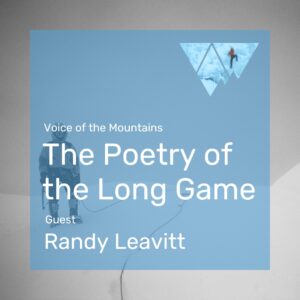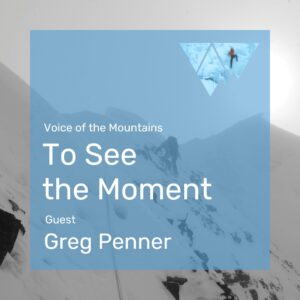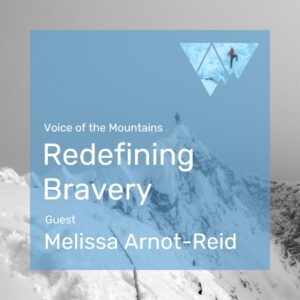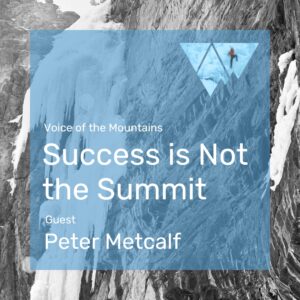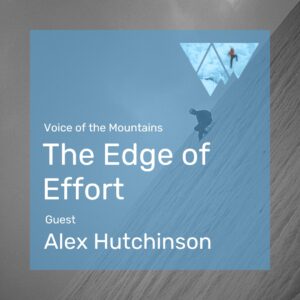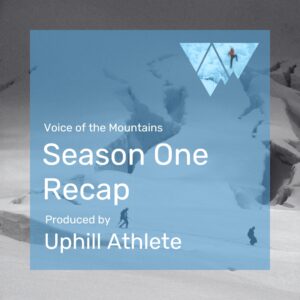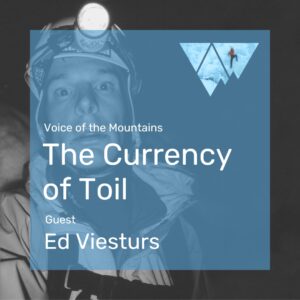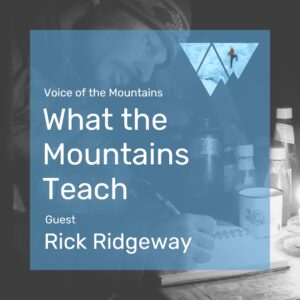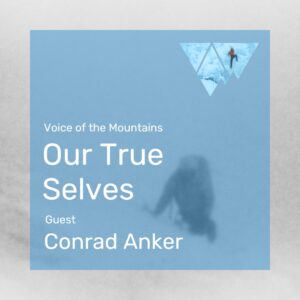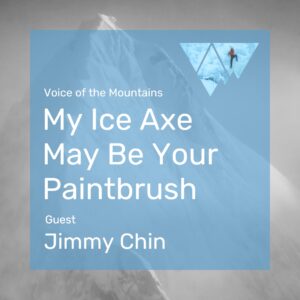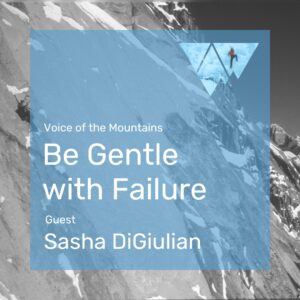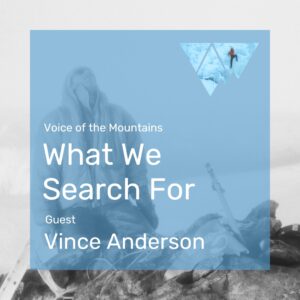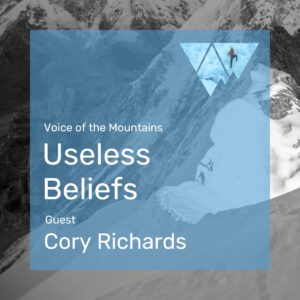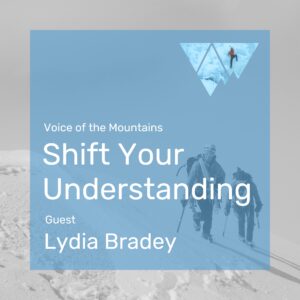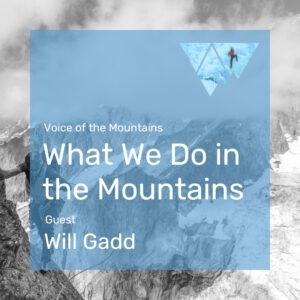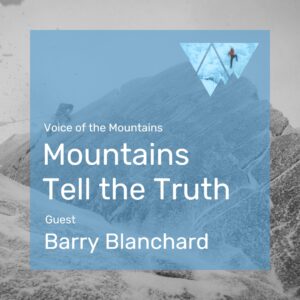Success is Not the Summit
Guest Peter Metcalf
Steve House interviews Peter Metcalf, the legendary climber and founder of Black Diamond Equipment, about his journey from young climber to industry pioneer. Peter shares gripping stories from early ascents, including harrowing ascents, which tested the limits of endurance and leadership. He reflects on how climbing instilled values of trust, humility, and calculated risk that shaped his approach to business. Metcalf also recounts the resurrection of Chouinard Equipment into Black Diamond, a climber-led effort rooted in shared purpose and cultural authenticity. Ultimately, this is a story not just about climbing, but about transformation, resilience, and building something that lasts.
READ THE COMPANION ESSAY
Exploring the poetic soul of the mountains.
Voice of the Mountains explores the mental and emotional adventures found in discovering who we are and what we’re capable of. Here we engage in self-reflection, humility, and embrace the beauty and struggle of the alpine experience equally.
Listen to More
You might not know the name Peter Metcalf, but you absolutely know his legacy. If you’ve ever clipped a black diamond carabiner, buckled one of their helmets or gripped an ice tool that made you feel just a little braver than you really are, then you’ve touched something that Peter helped build. Long before Black Diamond equipment became one of the most influential brands in mountain sports, and long before Peter became its CEO, he was an obsessed climber, a dirt bag with a dog-eared copy of Freedom of the Hills, sleeping in a little tent up in the bugaboos, hitchhiking to the gunks, and working his way through his apprenticeship as an alpinist by tirelessly climbing rock all summer and ice all winter.
In 1980, he and two partners set out to climb a new route on the formidable Mount Hunter in Alaska. They launched up this massive wall with nothing more than a rope, a rack, and the packs on their back. They expected their climb to take six days, and it took 13 on the descent they experienced full on out-of-body hallucinations, and one of them sadly lost all his fingers to frostbite.
The story of that climb is raw and real, and it’s a lesson in leadership under pressure and entrusting your partners. It’s a story about choosing unknown transformation over the status quo, and it’s a story about choosing to climb until they crossed over onto Sun Sue’s death’s ground, where the only way to live is to continue to fight.
A few short years later, Peter found himself facing a very different life or death situation. Sheard Equipment, the legendary climbing company, started by Yvonne Chouinard was bankrupt. Most people would’ve walked away, but Peter did not as the general manager, and against all outside advice, he organized a group of fellow climbers, not venture capitalists or bankers, climbers.
Together, they scraped together the money and he convinced his workforce to roll all their retirement savings into the collateral that they used for the loans, loans with frighteningly high interest rates and loans that they needed to survive. Peter will tell us what he learned in climbing his mountains and how those lessons shaped everything that came after for him.
How risk in the Alpine prepared him for risk in business, and how humility, honesty, and a shared purpose can build something that truly endures. This is a story about climbing. Yes, but more than that. In the true spirit of uphill athlete, it is a story about becoming. My name is Steve House, and this is Voice of the Mountains.
Steve House: Welcome, Peter. Thank you so much for being here today. Really appreciate you.
Peter Metcalf: Thank you Steve. I appreciate the opportunity.
Steve House: So why don’t you start us off just by telling us a little bit about how you got started in climbing, because as you know, and I know in our audience knows when you started climbing was not the more mainstream sport that it is today.
Peter Metcalf: Yeah, was very fortunate. Life is more serendipitous than most of us. Give it credit. And I did what most kids did in the mid 1960s in America, and I was just outside of the city. I’d been born in the New York City and it was just outside of the city, and I joined Boy Scouts. Serendipitously, the scout troop that I joined, we heard it was a good troop and I liked doing things outside.
I was 14 at the time. And it just hit me the, this unique activity I loved being outside and I saw it as a skill to learn because I loved being in the mountains. But there was something about this aian, bohemian, outsider, eclectic group of people. And it was a small group of white collar, blue collar people that just, it just spoke to me like it suddenly dawned to me, these are my people.
Steve House: your people. Yeah, that’s so, it’s as much about the people that were climbing having not climb, started climbing that earlier. But I mean, climbing has homogenized. So in some ways Right, in terms of the, the participation and the people that I see doing it, and not that that’s a bad thing, I think that’s a good thing and a natural thing, but I think people who don’t, didn’t climb in the seventies, don’t remember just how out there of a, how, how fringe of an activity rock climbing was. I mean there was basically no technology around it, right? There was, there were no cams. There were like the, the ropes were very rudimentary. I mean, you probably didn’t even have a harness to start with. You were probably just tying in with a bullet on a coil. I would, I would guess.
Peter Metcalf: No, it was, and then learned that, hey, a bowing and a coil is a heck of a lot more comfortable when you fall in a bowing.
Steve House: And just a straight
Peter Metcalf: But yes, you nailed it. I mean, it was very unusual. And when I came back to Long Island, just outside of the city and told people what I did, nobody understood it. Like, oh, you’re rock collecting. You are what? But it was okay. I mean and to the point you made about it was the people who attracted me. there was also, I loved being outside. I’d done some fishing, a little bit of hunting and many different things, but I didn’t have a vehicle to channel that love of the outdoors I needed something that could soak up my thinking, my need for activity in some focus skillful way. And I tried many different things. And, and at the end of that weekend, it just hit me that I think it’s climbing. I think this is my vehicle to love, to enjoy and, uh, just, just enjoy and cultivate my love for the outdoors and the mountains and the wild places.
Steve House: Well, as, as someone who I, I believe we both know, Kyle Lefkoff once told me like, if his theory is that if you have the climbing gene and you get exposed to climbing, your life has changed. And it’s just like you’re on that path now and there’s nothing you can really do about it. Its taken over your fate and, and directed you in that direction.
And that, that gene lays dormant in many, many people, maybe sometimes for their whole lives because they never get that serendipitous exposure
Peter Metcalf: Yeah, that’s, I had not heard that, uh, from Kyle, but I love that description and I think it’s very apropos. I think at the time as I got serious about it, I think some people would’ve been less gracious and said, it’s a, it’s a terrible addiction and it’s ruining your life. You know, all your friends, you’re gonna end up to nothing
Steve House: Yes, yes. That’s, that’s the flip side of obsession, right? Because it can also be addiction. So
Peter Metcalf: the point. I understand that as I tried to introduce some of my good friends City, I became in some households with parents, Pisana and Grata. I was the kid who was ruined attempting to turn their kids into delinquents, taking ’em to the Gunks.
Steve House: Yeah, yeah, yeah. You know, I was so lucky in that way, like with my upbringing personally, that my parents supported it and loaned me a car when I was 16 so I could go and my case to Smith Rocks in 1986 and like that. And, uh, not everyone has that, uh, that support and so that’s, that’s really, really great
Peter Metcalf: Uh,
Steve House: to express that and follow that.
Peter Metcalf: yeah, I fully agree with that. You know, when I saw the, I had accepted and taken my parents’ support of this for granted until I saw the reactions of other parents. I think what they saw was they provided me with a safe home and a good basis, but wanted me to have enough independence to experience the world in the way that they had. And though I didn’t have the benefit of a car, they were very willing. You know, this is their, the sixties, late sixties and early seventies, you could hitchhike, you could take the jump on the train, take it into New York City, which we would do, take the subway up to George Washington Bridge, walk across the George Washington Bridge and start hitchhiking on the Palisades every weekend.
And that was the weekend routine, they were very supportive of that.
Steve House:
So how does, how did, what was your journey like from going to the Swan Gunks to, you know, going to, to big mountains, um, in Alaska and elsewhere? You know, how did, how did that, what was that path like at that time?
Peter Metcalf: You know, I would first let me respond and say yes, I guess at the end of the day, I would have a point in my life definitely called myself, first and foremost, an alpinist over a rock climber. But I will say throughout that period of time, I was incredibly passionate about rock climbing. I just wasn’t at the highest levels. But I so enjoyed it. And it was what I did, the majority of my climbing along with the winter ice climbing and mountains. But when the weather was warm, I loved to rock climb. And so then to answer your question, the journey to that was the diet of books that most of us who got addicted to this sport in the late sixties and early seventies had, it was, I chose to climb by Chris Bonnington.
It was the Hard Years by Joe Brown. It was man in the mountains by Tom Petty. I mean, and what I saw in all these, in all these biographies or autobiographies that I was reading, and the people who introduced me to climbing at the ONGs, the A MC, they were all mountaineers. You know, alpinist wasn’t used so much at that point in time in America.
It was in Europe. but all of them were quickly telling me like something to the extent of, you gotta get these skills. And in the summer here at the Gunks, it is so hot and so humid. You gotta get the hell outta here. So what you do in the summer is we go to the Tetons and we go to the Wind River ranges and we go to Canada and things like that.
And I thought, oh wow, this sounds pretty cool. And, but in reading the, those biographies and hearing this, you realize, oh, there’s a huge apprenticeship here. How do you become a mountaineer or an alpinist? Like what do I need to do to go climb mount ropes in or go to Canada or Alaska? And you know, again, fortunately, this community of people I was surrounded with were including people who had done first of, since already in Alaska.
I mean, that was the a MC at this time. And I got a hold of the [00:14:00] Boyd Everett exhibition planner, you know, Boyd Everett was on that American Anaperna trip. Um, but I guess my point was, was really interesting about this only being 14 was that I had never done in my life at that point in time, anything big.
You know, at that age, you’re, you’re carefree, you’re running around, you’re doing whatever. And climbing, combined with reading these stories and go, yeah, I wanna do those things. I wanna go to Alaska, I wanna go to Europe, I wanna go to Mum Block. I wanna do the for eight pillow. I wanna, I think Sunday. But whoa, those, that’s a big deal. But you’re hanging out with people say, yeah, it’s a big deal, but there’s an apprenticeship you go through. So you’re gonna go, you gotta rock climb here, you’re gonna learn to lead, then you’re gonna learn how to winter camping, and then you’re going to learn step by step by step. And was really, think that has affected the rest of my life in that you can look at a goal and you immediately know how to break it down into all of its components.
number one, I loved the mountains. I loved the wild places, I loved challenges. reading these stories of Bonnington and Pat and, Don Willens and then Anna Perna, south Face of Haston. And, and well, Bonnington wrote it, but that is sent by Don Willens and, and Haston, who were the people who submitted it was like, I gotta do this.
I don’t know. It was just part of the, part of that gene that Kyle talks about.
Steve House: Mm-hmm.
Peter Metcalf: was, okay, what are the steps and how am I gonna do this step by step?
Steve House: Yeah, I, I feel like Scouts itself taught me that because you would have these lists, the Boy Scout handbook in many ways, for me was sort of this, it was a path. And it was like, do you do this? You do this, you qualify for this, you gotta wait this many months.
You have to assume this level of leadership within your And, and it’s like, okay, I could follow this list. I, you know, and then, yeah, you look back four or five years later and you’re like, you’ve learned all of these things. You’ve become, and I think that, that’s so interesting because I, there is, and what you said with outside there is absolutely this tension between, you know, this mentality that you’re describing where you working for a long term goal to, become something that is going to take years versus, I want to be that.
It’s, those are different, uh, you can be an alpinist perhaps in seven days, by some definition, but you haven’t become a new person through that process. And those are very different things.
Peter Metcalf: Right. It’s not been a metamorphosis. And you know, I had never before thought about what you just said about the Boy Scout, the handbook. But as I think about it, I, when I was done with my copy, it was so dogeared and I think like you, I read that thing, it, it sat by my bed every night before going, before it was, it was what I, I read until I fell asleep and I quit reading it and using it when I got serious enough about the climbing a year or two after I started.
And that book was replaced by something else that became very dog eared, but it had hard cover. It was called Mountaineering Freedom of the Hills,
Steve House: Yeah.
Peter Metcalf: showed you everything from how to do Tyro intro traverses to tension, traverses to Cavas rescue. And I would read that every night and go, okay, what am I gonna practice this season?
Steve House: Yeah, yeah, That’s, it’s, I did, did the same. I still have my Boy Scout handbook somewhere, it’s literally like, just disintegrate and it’s just a bunch of pages, you know, you like a, like an agent text or something. But, um, so you still haven’t answered my question though, like, you heard about becoming a mountaineer, going to big mountains, going to the Tetons and the Canadian Rockies in Alaska, Of course, yeah.
You’re 14, you’ve got some growing up to do as we all do, but at some point you made your way up to, to Alaska. And what was that, what was that path like? Who did you meet along the way? Who did you bring
Peter Metcalf: Yeah.
Steve House: along the way?
Peter Metcalf: So, you know, again, life is serendipitous. Starting at the Gunks one’s, very fortunate, a lot of serendipitous acts. That fall was a TV show, uh, uh, a one hour documentary. And I, I don’t recall what it was called exactly, but it was a documentary on Nolls, a national outdoor leadership school in the Wind Rivers and Paul Petzel leading a 35 day wilderness mountaineering course. well filmed, showing people self resting on snow, rock climbing, climbing peaks. I’m yelling to my parents, mom, dad, come in here. You gotta see this. I gotta do this, check this out. My parents caught a little bit of it and go, well, if you can figure out how to get there and do it, you know, whatever, do that.
So anyway, and I had, you know, that wasn’t cheap. I mean, I think cost nothing in hindsight, but it still was a lot of money to save up. But I had with my brother a little lawn business said, Hey, you can save up and do it. And I sent out for the course material, the materials applied for their alpine guide course.
I got accepted in early June of 1971. Went west for the first time, flew out to Denver. I, oh, I had a lie on my age ’cause it required you for that course to be 16 and a half and I was 15, I lied. I figured that that, no, I was pretty rabid and did that five week course, but that course was pretty incredible at that time.
Pet Salt, you know, who’s a legend
Peter Metcalf: was on it for the first 10 days and then he walks out bidding everybody a fair fa farewell. you head off up north towards Gannet Peak And because it was the Alpine Guide course, they wanted to teach you more about leading real technical climbing in the mountains they had hired. And he walked in there. We met him for five days in and around Gat Peak. Somebody who just before I went out there, I had read about. Because at that time the coolest publication that you could read about climbing was called Ascent. And it was the annual sublime, beautiful, form journalism magazine once a year of the Sierra Club. was an article in there written by Royal Robbins on the first ascent of Tisa Act, in which he wrote both his part and a guy named Don Peterson’s talking about Don Peterson is the young Turk up and coming and constantly challenging him on the route and not listening to his paternalistic wisdom and experience.
And they fought all the way up that route. It was just a amazing article and I had read it probably five times. I was like fascinated by it. So who walks in to the gat. Peak base camp Don Peterson looking every bit as tough, hard as Robins made out to be. And I was like, oh my God, this I am going to be rabid and just like do anything he says and be with him. And fortunately in this course, you know, five weeks in the wilderness, that’s a long time. Um, a lot of people were kind of burned out. And since it was voluntary, only two or three of us said like, yeah, yeah, I wanna do this, I wanna do this. we did a bunch of climbing with him. We actually did a new technical route, organic Peak together. I mean, just hearing his stories and climbing with that guy. By the time I left Noel’s, I really felt like I had definitely come up a level. And one of the young guys who I really hit it off with, whose name escapes me at the moment, but doesn’t matter. And I said like, as the course was ending, have you ever climbed the Grand Teton? And he said, Nope. And, but I’d love to. So as soon as the course ended, we grabbed our gear and said, man, we’re mountaineers now. And up to the Tetons, got to Jenny Lake, camped out there, and then started like investigating, okay, what’s the root and this and that. And just somehow in the process realized, in talking to people, they’re like, you know, you kids, I mean we’re 15 before you might wanna do the some ridge, you might wanna get a little bit more instruction. So we walked into the exim office and talked to Glen Exim it and he said, yeah, you know, we have this advanced climbing class that teaches more about leading, more about placing Pro with a guy named Herb Switzerland. We finished that thing, sorry, it was the one day, but we finished it with also a climb of Baxter’s. at the end of that Herb said, you know, I think your kids could do it. so we went up and yep, climbed the exim. We’re lucky to have lived through it because we didn’t start at 3:00 AM Um, we weren’t the fastest kids in the world and I learned a lot about afternoon thunderstorm.
So we got up near the summit in a raging thunderstorm with, I had long hair, frizzy hair standing out sparks flying between the ca few carabiners we had.
But anyway, we did that, came down, did a little bit more stuff and then I hitchhiked back east to get home. that fall, the next great thing was I got back and I’m not in doing anything with the A MC anymore, but those people I had met through the A MC were people I was doing some climbing with. And one of those people was a wonderful guy who has since passed.
Guy Waterman
Peter Metcalf: had been one of the instructors and he had two sons. Scooter, we had three. One had passed Scooter and um, Johnny Waterman and. He said that Johnny was a really good climber and he and a, another climbing partner of his, he was out west, a guy named Life Patterson, where the following summer, summer of 72, putting together two week long mountaineering courses. And they had this two week course they were putting together to climb Mount Robson by the cane face. it was glaciated to learn a lot about, more about glacier travel, this sort of thing., summer of 72 hitchhiked at New York City up to Montreal because at that time for 35 bucks you could go all the way out to the West coast on the Can Trans Canada train. we did research and they actually had a whistle stop at Mount Robson station. in the middle of the night after three days of travel, train guy, the conductor, agrees to tell the, the, the engineer to stop the train. We pile off at Mount Robson station morning, run into Johnny and Lafe and go packing into, uh, Berg Lake at the base of Mount Robson. when we get there, we run into a guy named Warren Blesser, who was well known at the time, had just done a new route, east Ridge of McKinlay or something. But definitely I’d read and heard of him, and Leif knew of him and his partner had just twisted his ankle. And was walking out and Leif was there, left with his dog, his Alaskan Malam, but looking for a climbing partner. Said, Hey, can I join you guys? And Leif said, well, I got these three kids I’m teaching to climb, but if you wanna join us, you’re welcome to. And Warren said, sure, let’s do it.
So we climbed the cane face, leading it and placing screws. And this is 1972. And this is part of what we’re learning about ice climbing.
Steve House: Yeah.
Peter Metcalf: we make it to the summit of ropes in, which is really cool, like Alaskan Peak with its ice fluting and stuff. And you know, you did that emperor fa route. Um, but we’re at this point now, the clouds are blowing in and it’s visibility is getting low and in and out of the clouds we keep hearing the, well we can see it, we’re hearing these whistles blowing one whistle, then two, one whistle, then two. And then as the clouds blow clear for a moment, we see down below a team that turns out to be a. Japanese climbers who had come up the other side, the ledges route or whatever the, the standard route is, and they had just made it to the, the base of the pyramid and they’re solely working their way up. Anyway, that section, as you know, is not that steep. It’s probably only 30 degrees or so. it’s getting late and the only way down with us is we’re gonna wrap the cane face but the can’t repel.
we did that and got to witness the first ascent of an ice, real ice conditions of that climb. We all came down and actually then afterwards, still had enough time every two weeks and did a new route on Whitehorn in a day. Um, well,
Peter Metcalf: but all of us, I mean, it was coming down in the dark.
We didn’t have headlines, just little flashlights. And the three of us who had never done an unprepared biv wh before, kept saying to, to, to Johnny and LA, let’s do a bev. Wh we gotta learn how to biv wh and um, finally they capitulated and said, all right, you wanna be miserable. I understand what it is to do an unprepared biv wh up, alright, let’s do it. And shivered through the night, never slept a moment, put every stitch on, lay on the ropes and learned what it was like to biv wh and got down, walked out. And then after that was a great trip and decided, all right, still got a two weeks left, hitchhike down to the bugaboo and had a great eight or nine days in the bugs and got to do everything from the standard roots and bugaboo and snow patch to the cross McCarthy on snow patch. Pretty good roots for the day.
I realized as did some of my other climbing buddies from the Gunks who had had similar experiences, we, we need to do something bigger now. We need to go to Alaska. We’re ready. We wanted to do something technical. so, you know, doing the research, he found out, oh, Brad Washburn the Museum of Science had this amazing archive of, from his aerial photography days, photographing every Alaskan peak. And that he, he would allow you to come up there and go through his books if he made an appointment. Brad looked at the photos with us and helped us and they said, well, there’s, that ridge is undone. That ridge is undone. That one looks really cool. And he goes, I would go do that one. You guys can do it. I mean, you’re gonna be college kids in another year. I mean, yeah, go do it.
Peter Metcalf: so we got to Juneau, pulled off there, pulled into Ken Loken, he was the pilot’s office, walked in and I think we called our, I forgot what we called our expedition.
We came up with a name. Everybody had a name for their expedition.
Steve House: Right.
Peter Metcalf: And we walked in and we said, we’re their so-and-so expedition. Ken [00:39:00] Loins, administrative assistant secretary, et cetera, office manager, looked at us and said, do your parents know you’re here? You’re the expedition. Yeah, that’s us.
Steve House: We were expecting actual full grown adults,
Peter Metcalf: Yeah, yeah, exactly.
Steve House: bunch of
Peter Metcalf: It’s us. So anyway, Ken flew us into Latu Bay and we spent 28 days in the mountain. Um. And had a phenomenal time. So we did get flown in first and right there, but initially, you know, we’re fearing loads. We got days worth of food, ropes, et cetera. And during our climb there was a massive earthquake and thank God where we were on the ridge because every face in that circ of every peak, fully avalanche. it was an incredible experience and that, I guess is the, the journey to Alpinism in Alaska. And then of course my appetite for Alaska was now turned on.
Steve House: Yeah. And you know, I mean, I think any alpinist that you talk to has threads of this story in common, whether it’s, you know, the people they met, you know, the, the, the things that happened. Just, just so many. you don’t realize as a young person, when you step into these theaters, you really do step into history. Like you step into live history that’s being written by your being there and these other people being there. And, and I mean, these are our shared as our shared history and culture. Uh, and, and there’s so much that’s familiar with, with, with your story that not not having known any of this from you personally, but so much of these threads are, are, are familiar.
Peter Metcalf: Steve, that is so well, said. And I’ve, I’ve thought about that myself in that perhaps that’s why for our generation, this history so powerful and why we read all these books and biographies because was tangible. We met these people, the we, the legends, we got to actually hang with and be around.
And it wasn’t elitist. You just, it just what you learned from their presence and seeing them was just so powerful.
Steve House: Yeah. Yeah. So you, you, I think it was, correct me if I’m wrong, but two years later went to climb Mount Hunter by a new route
Peter Metcalf: No, it wasn’t. Yeah, but you, you, you got a good part of this down. So two years later, I go to do a new route in 1975 on Mount McKinley, we called it Reality Ridge, the Southeast Ridge of the South Spur. And it was with several of the same people who I had done Fairweather with three the same, two of the same, and one new partner, a partner that I had met in the fall we got hooked in Alaska and began looking at let’s do something on McKinley or Logan or St. Elias. came across this, the reality, what we called reality where the southeast spur of the southridge and decided like, okay, let’s go do this guy and let’s do a capsule style instead of leaving a bunch of ropes. You know, this is still before things had being done Alpine style up there. was still not that good.
It was better than, than it was two years earlier. Um, and so what we ended up doing was driving the Alcan that time up to Alaska. But first I spent the, the spring living in the valley, and my buddies picked me up in California at the valley with my other climbing partner, and we drove up there with all our gear.
And then like a tugboat, lashed, extra tires onto the front of the car like bumper guards and drove the Alcan. It was still dirt up to tna, flown in and did this new route on McKinley and did kind of a circumnavigate because what we did was we had 10,000 feet of rope that would pull the polypro reality original until we got to the top of the South Ridge. we buried it into Casse deep down. then from there, I think we had a fair one or two more loads, went into Fair Basin then up at a Fair Basin up into, it’s really, I guess the west, the um, Mulrow route and over to Denali Pass. And then the weather wasn’t so good. So down to the high camp at 17 two, did the summit and came down to Hiner route, down to base camp and that was 45 days. Uh, it’s a long time to be in the mountain without a shower or anything else. Amazing experience. It worked
Steve House: That’s a pretty significant achievement, just keeping yourself supplied with food and fuel and everything you need to survive in Alaskan conditions. For, what? Six weeks?
Peter Metcalf: Yeah 45 days is a long time. Fearing all our own gear and loads food and pulling ropes out, re-fixing ’em, pulling ropes out, refix ’em and all of that. And uh, I think our theme song about the 30 day mark became Paul McCartney’s, if I ever Get Outta here. Um, uh, but great experience and, but well in TNA both waiting to get flown in.
I think we had to wait that time, five days, even though at times it looked really clear And I kept looking at Hunter and from Tona, the central R of the South face, it’s like a gigantic walker spur.
Steve House: Mm-hmm.
Peter Metcalf: I looked at that thing, I thought that is one of the most aesthetic lines I have ever seen asking around. Nobody knew if it had been, nobody thought it’d been climbed. I just thought, well, if it hasn’t been climbed, that’s my next objective.I have to go to college for a year or two at least. I did the, uh, seven and a half year college program, year on year on year or year and a half off, year on, year and year a half off, started scheming so the next two years I ended up climbing in Europe for two summers with uh, hosted different partners, doing those great route and really getting great experience decided, okay, 1980 we’re gonna go It was Charlie Fowler who I’d been climbing with in the Alps, Rando, who I had done a ton of climbing with and had just done a new route year earlier in Mount Huntington and me, then Charlie fell in love decided he’s not going. So somebody else who I had not climbed in the Alps with, but I had done a lot of rock climbing and ice climbing with, as said Glen, was Pete Athens. So talked to Glen and said, I’d like to invite Pete. Did some more climbing together and game on. it was up to me to sort of organize, okay, what’s the style?
How long’s it gonna take? ’cause I’d been there before and planned the trip out. anyway, did that. And that’s what Ultimate got us to in the May of 1980 to Tona and the Toa, the base of Mount Hunter to try it again.
Steve House: Mm-hmm. Mm-hmm. with a totally different, what was the group dynamic on that trip?
Peter Metcalf: It was phenomenal because I had, yes, I think sometimes you don’t know what you don’t know until you know it. I mean by that is you sometimes take things for granted. So my first two Alaskan trips, I. were great. We had spent time together and just, and I just thought like, yeah, you climb something with people, like get along, we get along, we, we do. it’s all good. And then on that first hunter adventure, I realized among some of the other reasons we failed that no, it’s not a given, that people are going to in these very stressful, very challenging situations that they’re gonna mesh and bring out the best in each other and support one another. that was something I was highly cognizant of with this team, um, in what we needed to do this. I also recognized at this point, having been there once and been on it and backed off of it, this was going to be the most, up until that point without question, most serious climb in my life. And it was a climb that I also realized and explain to Glenn and Pete, is this something we might not come back from? And, and it’s not that we had a death wish, it was just that this was important enough to me, and I wanted to communicate that to them, this was gonna take everything we had. We had to be our best. And even with that, the outcome was not guaranteed, is are coming back. And I remember at this point, because I had, I won’t go into details, I had already had, now several partners killed climbing and people I knew well. And so I had to go through that experience. Actually, the previous summon in Shani, one of my, my climbing partner from Fairweather was killed and went through that experience of having to tell his wife, call his dad, meet them at the airport, and go through that trauma. And I think my realization at this point in time was also that not only do we have to accept our own. Risk factors in this, but we have to understand that there may be other people who are going to be affected if we get killed. And we need to make sure those people know what we’re doing and why we’re doing it. And we accept the risk and understand that so they can accept that. And I actually wrote a letter to my parents and said, do not open this letter. My brother saved it. Explaining that to them. I said, open in case of problems or something like that. I think I gave it to my brother and explained it to him ’cause he had it. Um, so I just share that because we, uh, wanted to be sure they, and all of us understood what we’re getting into and why it was such a, the dynamics so important and the training and thinking through every piece of gear we had, um, and testing it beforehand and making sure that this was right.
Steve House: Mm-hmm. Yeah. And, and you, you chose Glen and Pete rather, I don’t know what the right term is. Uh, deliberately. yeah, that takes a lot of self-awareness and you have to be, I think, pretty vulnerable with what that means, right? Like you have to be honest about what the, what, what you’re actually talking about. You’re actually talking about life and death and as you said, affecting how that affects other people, you’re choosing to do and why you’re choosing to do it. Those are a lot, that’s a lot to, uh, lay out.
Peter Metcalf: Yes, it’s really well said Steve. And I would also add that, you know, I actually, at that point in time, Pete was not the climber. He became, I think Hunter was a giant stepping stone his becoming the great climber he became, because up until that point he had left into Alaska both Glenn and I recognized, I had climbed with him.
By the way, the previous summer in the Alps, we had done the American direct on the, on the drew and in three or four days and several other longer multi-day route. And so at this point I was definitely much more experienced than Pete. Um, but he was strong. And to the point you just made is that it’s not only experience, I mean technical ability is really, really Im experience. I would add that if I’m having to true choose between experience thoughtfulness and awareness and chemistry of the team. I would choose the latter. And what I knew with Pete, having been through some challenges on, on the climbs we did, guy is very thoughtful. He has humility. He knows what he’s willing to admit when he can’t do a lead, and he’s willing to tell you when he can. Um, and to your point you were saying earlier is that in the team dynamics, what you to, you have to have a hundred percent confidence in the competency of your partner, and you have to have a hundred percent confident there’s enough brutal honesty with your partners. That they’re not gonna take the lead in a, in a situation like this where you can’t fall if they’re not up to it, that they have to say, I’m just not up to this.
Steve House: Yeah.
Peter Metcalf: like, Hey, I’m up to this. They, I’ll, I’ll do it. And they just have, they have to be able to say anything and everything that’s on their mind that’s gonna perfect affect their performance in a realization that, you know, this is really a cliche that, but it’s so true. It’s like are only as strong as you weak as a member.
And if somebody’s not healthy and well, and you’re not taking care of your team or your partner, you’re screwing yourself.
Peter Metcalf: Um, so there’s all, those are such important dynamics in working with a team of people to get things done. you are looking for humility and, uh, a lack of hubris in people so that they’re so honest and acknowledging their fears, their concerns, and that you can talk through things and find a com, uh, a solution everybody can agree with it and not fight over it.
Steve House: Right, right. Yeah. And around this same I’m not exactly sure on the, on the timeline here, got involved with a young company called Chenard Equipment. You wanna tell that came to be? Because you know, you are best known to many as. I don’t know, uh, what the right title of it for you was if you were the, the founder of Black Diamond, because you did reincarnation art equipment as black diamond equipment, and then you led that company for decades, uh, until its eventual, uh, sale and then remain involved to this day. With that, with that company’s been an incredibly influential, you know, company doesn’t do it justice, but it’s, you know, black Diamond itself in part through you and, and all the others that worked on it. you were, you shaped our culture, you shaped our conversation. You, you shaped our vocabulary in many cases. You, and you’ve absolutely shaped the technology that we all used. So I want to get into that, but I Wouldn wanna hear how you got into that and how that came about.
Peter Metcalf: Thank you for those very gracious comments, Steve. I, I appreciate them. So, you know, America is a place to be a professional climber in the 1970s into the early eighties is very, was very different than it’s today. I did like my academics. Um, I didn’t know what I wanted to do other than I wanted to climb and I wanted to work as little as I could and climb as much as I could. So I lived as frugally. I, I didn’t own a car. Um. Until I went to work for Yvonne and I, it was 1982, I finally bought a car. Um, but the goal was climbing and I survived. Doing what climbers in that period of time did was I worked out bound often. did a little illegal guiding. I worked as a helping out at the climbers ranch, some at the Alpine Club. spent two winters throwing chain with Mike Munger and Angus Theurer on drilling rigs in Wyoming. Uh, in the winter, I was a chain hand on wildcat rigs
Steve House: Oof.
Peter Metcalf: you know, it’s reasonable money and, uh, but not great work. I realized that by, and by 81, I was starting to think like, is not a good long-term sustainable model. And I was looking at Fred candidly and going, I wanna have more of a career than Fred. I got, I, I I need something besides just climbing and working on rigs, working outward bound, picking up work.
That’s, that’s not a future there. I need something more. And so this is 1981. And, you know, I’m traveling, climbing with, you know what I called the more serious climbers of America at the time. And a few of them are starting to get this new job, which I’d never heard of. It’s called Sales Repping. And it seemed like they could keep climbing and they had own cars and they would just stop by all the retailers I knew. I knew Bob Kalp, I knew Gary Neptune. could go talk to those guys and they’d just show ’em some product, talk to ’em about product and get orders, go to the next shop, go climbing for a couple days.
And I thought that might be an interesting way to break into a career. So I just started sending out letters to people I knew at companies that I had hustled free gear from, for expeditions that I was aware of this, you know, here’s who I am, you, well, you know who I am, and I’m ready to start getting more serious about working. And I think I would be a great rep corresponded with all of ’em and whatnot. And one of the companies I sent a letter to was, I didn’t know Yvonne, um, but I had met him, but he didn’t know me, but I knew people who knew him.
Steve House: sorry to interrupt, but we’re talking about Yvonne who founded Sheard Equipment and Patagonia
Peter Metcalf: yes. And so started corresponding about a rep job. And I got a, and Patagonia, Chris McDivitt, who was the, at the time, general manager of Patagonia, replied and said, um, Yvonne says he is interested. We’re interested. We’ll talk to you. don’t you come to Chicago? There’s a trade show in Chicago at this date and interview. And I just wrote back a letter. At the time, I didn’t tell her I didn’t have a car, but I didn’t have a car and I didn’t have any money. And I’m like, I’m not going to Chicago with, to the interview for this job. And then another opportunity came up somewhere, but at this point, climbing was working really well, and it was gonna be a sacrifice to go somewhere to interview for the job. And I just blew it off. I didn’t even respond. And I just, at this point, so now we’re at the spring of 1982 and I got contracts that summer with Outward Bound. I fly up to Alaska in May But when I get back from Alaska in late May or early June, there’s a letter waiting for me and it’s from Chris McDivitt and she begins with, this is the last
Peter Metcalf: And she says that last year split his companies up it at this, up until 1981, there was one company and it was the maker of, it was shard equipment and it had Patagonia clothing, it had SCH equipment, climbing hardware and GPIW, which was a retail store and a mailer operation. And what the letter said was, we split companies up. I’m running Patagonia. Um, else is running GPIW retail. thought he was running shard equipment, but it’s become clear to me and him that somebody needs to run it. And at this point, the company is sub million dollars and it’s declining. And you cannot tell the history of global climbing without telling the history of shard equipment, whether you’re talking about big wall climbing and peons or free climbing hex, centrics and stoppers or ice climbing with the, the rigid crampons and curve pick tools. But had begun really focusing by the late seventies in Patagonia. by 1982, that company hadn’t even done a catalog in a couple of years, wall country was crushing it with its rocks. And now, uh, uh, friends and shuttle equipment was going backwards very quickly, the reputation was strong. You don’t ruin a reputation like that, um, very easily. And I should add that to me and many people of my generation, when I received. The 1972 Schade Equipment catalog, which was not a catalog, it was to us in my generation of climbers, what MA’s Little Red Book was the cultural revolution. This was something that, yeah, it sold some gear, but it told you how you used the gear, it told you how you dress. It told you what your ethos were, what your ethics were, what your morality should be.
It it showed you how to dress, how to act, how to behave. I mean, this was template. I mean, it was like Yvonne was the angel,
Steve House: Yeah.
Peter Metcalf: this powerful, and I share that because become, know, just a, I was a full-time climbing bum. I had produced my worldly possessions down to literally a single hall bag.
I didn’t own a car. And I had that catalog in there, that catalog I had, I still have it today, 50 years later. Um, so to me, when this letter comes and I’m told that Yvonne is looking for a general manager and that looked at my resume again and said, give that guy a call let’s interview him. thought, alright, stop everything.
This is, this isn’t a rep job. This is to go work for guy who wrote the little red book.
I sat down and put together a Twop page letter to Teon saying, this is why I want this job and why I think, um, even though I have never run a business and whatnot, I, I think he could train me.
I think I’m the you guy. And for the first time in my life, threw down, rode my bike over to the FedEx office, threw down what was a lot of money, 25 bucks to mail somebody a letter he would have it when I called. so then this prescribed date called him up and said, um, Hey Yvonne, it’s meet Peter Mc. And he goes, knew immediately I’m off to a good start when he said, yeah, I got your letter. That’s a great letter. Let’s talk about it. Had a long conversation with him. And then he drops the bombshell. But he goes, I can’t hire you off of a letter or a phone call. He goes, we gotta meet and spend some time together. I go, oh, where I go? Coming out to Ventura is not easy for me. he said, well, I’m in the Tetons. I go, well, I got these three contracts with without rebound this summer. I’m leaving shortly. I gotta start working. And he goes, what are the dates? And I tell him, he goes, you gotta break in between those. yeah. And he goes, well, I’m teaching an ice climbing course for three and a half days in the tee time, glacier through exim, uh, on these dates. You’re free then. And I look at it and go, you’re right. And he goes, up here. you tell you teach, help me teach this course and then we’ll spend the day with Melinda at the house and that’s gonna be your interview. anyway, I get that with Bound and talk, one of my buddies into who has a car, and I said, Hey, I’ll pay all the gas to Jackson on our break. And you get to meet Yvo Sheard. All we gotta do is walk up to Surprise Lake you can join in on this ice climbing course if you want.And I just tell him finally like, Hey man, this is Yvonne. This has been great. And we talked about, by the way, I should say in the interview has been talking about what would I do? What, what gear ideas do I have? I mean, it was a very intense interview. And I finally just said to him, I gotta run man. Um, where, what do we do from here? Yvonne pauses a moment, grabs this little piece of scrap paper, writes something on it, and hands it to me. it’s a, an address in German. And I said, what is this? He goes, an address in Germany of my, of the sales. The guy we just hired. He’s a climber. we just hired, we’re gonna set up business in, in Europe. There’s a trade show in Munich, Germany called Ispo in September, mid-September, and this guy’s gonna be there. And that’s how you’re gonna start. Just find your way to that address on that date and you’ll meet this guy and start at the trade show and that’s gonna be how you start. And I get up and go, thank you so very much. Well, I’ll figure it out. You know, it’s been two, the past two seasons climbing over there. Um, I’ll figure it out and go there and then I stop a minute and go, what one question, uh, will pay for this flight, right? And he goes, you get there, I’ll Refunder.
And I go, oh, one other question. What am I getting paid? And he thinks of it and he goes, $15,000 a year.
Steve House: just gotta say, having no, having known Yvonne for myself, I mean, for those of you that are listening that haven’t seen ev, Yvonne, or interacted with him, know, you’re just playing him to the letter with, with just the mannerisms and, and how he thinks and, and how he, you know, how, how resourceful he is.
It’s a scrap piece of paper. It’s not like he doesn’t have, you know, it’s not prepared, it’s in his head, but he’s making all the right decisions.
CTA: If you’re enjoying the show and want to take the next step in your training, join our newsletter and receive a free four week sample training plan. Head on over to uphill athlete.com/ let’s go, and once you sign up, you’ll instantly get a link to try out some of our most popular training plans. It’s a great way to get a feel for how we train our athletes for big mountain goals. Check it out@uphillathlete.com/Letsgo. That’s uphill athlete.com/letsgo.
Steve House: there was a time where people’s work identities and personal identities were highly separated for the
Peter Metcalf: Yeah.
Steve House: right? Like traditionally, like that’s how my parents grew up. That’s how, culturally, that’s how we were. One of the things that was always different at Patagonia is that was not the case. Because when I got hired on as an ambassador in the late nineties, we went to Yosemite with Yvonne and Melinda and a couple and Ron Co and you know, Dean Potter and Steph Davis. And we went, we rented a cabin and we went walk for walks in the woods and talked about the philosophy of climbing and, and, and cooked meals together and slept, you know, we all we’re sleeping on the floor in the living room. And, and you know, that’s a very, very atypical, especially at that time of, and now if you fast forward to the current day, I mean, maybe because of remote work, it’s shifted, but. has much more common culturally for people to integrate of themselves and do things. Yvonne, I think was, again, as you said, his instincts were always so good. he’d rather hire a climber and teach them how to fill in the blank than the other way around. Because then he had, uh, common ground and cultural, cultural fit, and you really carried that, that through as you, you know, created, uh, the culture at Black Diamond.
I mean, I was around black diamond many times over the decades, and all those people that were there were climbers. I think every great climber and least in the United States worked for you at some, some
Peter Metcalf: Yeah.
Steve House: that a conscious thing that you engineered af that came out of your experience with, working, starting with Ard
Peter Metcalf: Yes, absolutely. And I just wanna say that you’re absolutely right about the chouinards and because it was the first real business I ever worked at, to me what was among so many things that were so compelling about it were just those attributes. That there wasn’t a bifurcation between your workday, your friends, your social life, your, your passions. It was all one, it was seamless, right? And so the desire to follow that, that’s what I knew in creating bd, but there’s a lot more to the BD than just that. Um, was, was just a very natural thing to do. And I should add that it was years later I read that Warren Buffet quote that I thought captured this what you just said.
So well from a business person, which is. The culture eats strategy for lunch every day, and that was something Yvonne understood so early on in starting his businesses the culture, the human dynamics, how people get along and that you’re a team.
Steve House: Yeah, that’s so true. And one of the things that I think that in my experience carries through is you’re in the mountains doing these things, uh, it’s very vulnerable many times, right? Like, as you said, you have to, have to, you have to speak up when you can’t lead the pitch, you have to speak up.
When you don’t feel well. You have to ask your partner how they’re feeling. You maybe have to step up and take the lead when you didn’t really want to. Um, and there’s a certain intimacy to that and being able to, that, that translates very well to the, in my experience, the work environment to being able to say like, Hey, uh, this is going on for me. You know? if I feel a little, I don’t know, edgy today, then it’s just because, it’s not because I don’t like your idea about, I don’t know the catalog, it’s because maybe, you know, my dog’s sick or whatever it is. And, and that, that seems to like reveal or a lot of the friction for people
Peter Metcalf: Yes. If you could be that open and not feel like there’s gonna be any retribution or crimination because of that, that’s really healthy.
Steve House: Yeah. You talked a little bit about how, you know this moment of when, you know, and this is I think, unique to the time that you were climbing, where we were transitioning away from like lot, fixing the entire route to pure alpine style a sense. And that was very common. Even, even when I was younger, we used to fix the first two pitches and, and so on.
That was like a very common practice then, and you know, and then you talked about that cutting, the, cutting that tether and, and heading up on the root. Can you describe a similar experience that you had at Black Diamond that you, that felt similar?
First is an alpinism as an business entrepreneurship. If it’s not, um, something like with a bunch of venture capital and whatnot, it put you in situations of serious consequence. put you in situations of serious consequence. and secondly. There is an incredible tension between the need to prepare, organize, strategize, um, and the need to just cut loose and go for it.
Or as Patton once said, you know, the minute the the door, the, the land, the landing craft opens on the beach and you’re being fired upon everything you know has just fallen by the wayside. And that’s not quite true. But it’s, you, you do everything you can to prepare and then you gotta start being agile and improvise and whatnot.
.
it’s what people have to realize is that the transition from Sharon equipment to Black Diamond was not quite as seamless as people think it is. I mean, what happened? And, and to tell that story, you really have to understand that. There was a big bang, it’s what I call the big bang. There was a big bang that hit America’s outdoor industry in the latter part of the 1980s.
And it also hit the sports, um, of climbing, backcountry, skiing, mountaineering. And when I see the Big bang, it was the confluence of several big social demographic and legal trends. One was the creation and birth of what we call tort law. And up until the mid 1980s, tort law, IE the ability to sue landowner, whether it’s the government or a private individual the fact that you got hurt on their property and you can claim attractive nuisance, that they didn’t block you, they didn’t warn you, whatever didn’t exist.
so you had the revolution, tar Law and Charlotte Equipment went, uh, I mean many companies were being sued out of existence. Football, helmet, manufacturers, playground manufacturers. the list is go is endless. And that’s where we see all these warning stickers on things comes down to the, the outdoor industry. Schade equipment received in rapid succession, a series of very serious to warn lawsuits. They never claimed that the product but they claim that the product failed to perform in the situation it was being put to, that the user wasn’t properly educated, that the user wasn’t properly warned about the limitations of the product. that’s because up until that point in time, all assumed that. The person buying this gear or equipment would only be buying it because they had gone through the apprenticeships that you or I and everybody else up until that point in time had. And so as a result, insurance premiums went through the roof. are receiving lawsuits and losing them that are causing them to file for bankruptcy. Concurrently, you’ve got land managers changing situations, beginning to ban things like climbing. Um, you have ski areas that, if you remember 1980s Colorado or Utah, there’s that your lift ticket said, do not, if you ski outta bound is illegal to ski outta bounds of any area. And if you do, lose your ticket. You will spend one night in jail and you will be fined $500. That was when $500 was probably like $5,000 now.
There was no Winter Wild Lands. The access fund was not even created at this point in time. was no, uh, I think, uh, American White Water, um, these groups didn’t exist. And there wasn’t even an OIA at this point. I mean, the, the industry hadn’t even organized a trade group at this point in time. And so this was a huge wake up call. And so 1989 was the year the access fund was formed, was being formed out of the American Alpine Club. Some of these other groups came [01:41:00] later. But as a result of all this, and I should add, there’s one other thing that was going on here is to but discreet from. you know, if you wanna put the, the, the birth date of Black Diamond legally, it’s birth, it’s creation, it’s founding 1989. That is correct. If you want to talk about when was it really founded, when was the ethos and the values in the beginning of it? It was 1982 when I was hired because Schade equipment had been going backwards for a couple of years. No catalog, no new products. It was a becoming an also run, and I don’t say that with any disrespect for Yvonne.
He was just now focused on Patagonia and not climbing very actively anymore.
I began to, as I start growing the company, I had permission then, okay, you could start hiring people. And so who was it that I wanna hire? I wanted to hire my friends, meaning climbers. People that I had climbed with or knew of would interview and talk through and start building a community of climbers because that didn’t really exist over at Patagonia so much anymore. and, and so that started there. Um, and it was also a realization that we had to really move the forward with the sport to me those who I was hiring the future, the golden years, because I was, you know, I was 20, so I was 27 when Yvonne hired me. The golden years were still at the windshield. weren’t in the rear view mirror. And at the moment, a little bit for Yvonne, with all due respect, the golden years were a little bit more in the rear view mirror. And he had a high set of ethos, his values and such were, that didn’t really believe in sticky rubber bolts, chalk shamming devices at the time. I mean, he moved forward with it over time. a lot of what was starting to happen in then the, in the, in the mid eighties and late eighties. As sport climbing took place.
And if you certainly remember those debates, the, the hang dogging and the great debate that the Alpine Club had, we all went there together. Yvonne, Melinda, myself, from, uh, Chouinard. Um, but as a result, and Yvonne gave me and the people I hired and my, the marketing director I hired, Mariah Kraner was absolutely brilliant, um, at capturing ideas that I had and how to manifest ’em.
I did the first couple of catalogs and then I hired her. but as a result of this, it was also something that was not overly pal palatable for Yvonne. He wasn’t happy with it because as he said, gosh, this company is moving in a direction visually, image wise, gear wise, product wise, ethic wise, embracing sport, climbing, the clothing, this gear, don’t really believe in it.
And so it’s challenging for me as Yvonne Chouinard, it’s my name on this company. this was a, a source of great strife between myself, Mariah, me, and Mariah with Yvonne, which I respected that and knew it was a real problem. But then you add to this what I call the big bang that hit the industry, all the challenges and then the lawsuits hitting, and suddenly our insurance premiums went through the roof beyond what this company could afford. And it also was the fact that she, equipment was part of this corporation of Patagonia now, which was become a much, much bigger company. and, uh, lost the great Pacific Island worked was now the mail order and retail operation was much, much bigger. And it was clear to any good attorney that somebody might be able to pierce the corporate veil and attack Patagonia, let alone literature on equipment now, which I had grown to $5 million in revenue and I think it was a leading company first period once again. Um, but between that. Yvonne’s sort of own beliefs about where the sport was and what I was doing with Mariah to capture that, that leadership position. And then, gosh, the risk, and then the lawsuits. And now it was not profitable because of the size of the insurance premiums. He had it. And he finally decided in the spring or late, early, early spring or the end of the winter, or it was early March of 1982, he filed it for bankruptcy and just said, we gotta, it’s over. not worth it anymore. And he said, I want you to put together a plan to liquidate the assets as quickly as possible with the least cost to the company, but you can spend a couple of weeks first trying to find a buyer, find a buyer, otherwise we’ll just liquidate it as quickly as possible.
So I got working on that, met with a few different people and entities and people looked at it and just laughed, why would anybody wanna buy this? thing is losing money. can’t get insurance for it. Um, there’s all these lawsuits, there’s no future here. I thought about it and had an epiphany and realized, wait a minute here. I’m not about to just surrender and, and make a mockery of my last, what was eight years worth of effort in rebuilding this company into the leading climbing equipment company. Again, hired so many of my community at this company. Now we have a, a good number of people, community’s depending on us in what we’re doing as far as innovative gear, the catalog. And I said, I don’t wanna make a a, I don’t want the legacy of that. I, and, and my generation have been raised on, have shown equipment to go to nothing. More importantly, if this company disappears, who, what is gonna champion the issues of great importance to a fellow community of, of mountain sports and theaters, climbers, albin, and off peace skiers?
To me, it was, this wasn’t about looking at a group of consumer potential consumers and saying, what can we sell to these people? It was looking at a, community and saying, what needs do they have? services do they need to have provided and we’re gonna provide them? And because this business will be created to champion the issues of great importance to a fellow community of technical mountain sports enthusiasts. to champion the issues of great importance, which I define as good, safe, innovative, high performance gear. It was to continue to affirm and, and celebrate your decision to be a climber and to champion the access to and preservation of the Mountain Canyon Craig environment we also love and our sports and activities are absolutely dependent upon. So that was the vision. I shared that with employees and I just said to them, look, I don’t have any money. Very little. I’m not paid that much. You guys I know don’t have a lot of money, but don’t leave.
Steve House: Right.
Peter Metcalf: And stay, come on guys, stay. I wanna start a new business. It’s gonna take some time. I’ll figure it out. Gimme some time to do this. And so one, the chouinards agreed to gimme some time. I said three months. It turned out to be about eight months of hell. finally found a commercial finance company who agreed to do the deal in LA at interest rate of 12 and a half or 13% a point to originate. And I said, no, but I’m not giving it a personal guarantee. I said, I’m not even gonna be a 10% owner. I have 38 employees who will be owners. I have a dozen outside people who are gonna be owners. I’m not giving, I can’t give it a personal guarantee. So the last night in November, early November, I go down to LA sign all the papers and these guys at the commercial finance company with their gold chains hanging around their neck with their open shirts, say, sign all the papers, and then go, oh, yeah, forgot two things. The uh, success fee. It’s a point, a point of what you’re barring. And I said, oh no, we got it. It’s, it’s the origination fee. That’s the origination fee. This is success fee for the team here to split. And I go, you gotta be kidding. You go, there’s no deal if you don’t sign that. So I sign it. And then you go, oh yeah.
And one other thing, you know, we were really torn over this personal guarantee, we gotta have it. I said, you gotta be fucking kidding me. And they said, no, we gotta have it. And at that point, you know, it was so much at stake and I thought about it and thought about all the commitments people made. I realized what the hell, I mean, I’m still young. My, I don’t have that much equity in my house. I had talked this through with my wife and she was willing, as I said, if we have to just leave town in my old Volkswagen, we, we still can start over, right? And she goes, we could. So I signed it.
Steve House: Wow.
Peter Metcalf: But talk about, I mean, just like Mount Hunter, when you, didn’t talk about it fully, but that moment where you realize on day three you can’t go down anymore, the only way to to do the Root and Live is up Upward Bound. And my attitude at that point was the only way to give up everything I have, including my house, and to realize his vision with all the employees is move forward and succeed.
Steve: So how did you bring people along for that?
Peter Metcalf: it’s, it’s a very good question I think what is so crucial is if you’re a starting something, are you doing it because you’re trying to make, make money or, which is not very compelling to anybody unless it’s a bunch of people in tech, like, let’s see how quickly we can this and go public and get the hell out and make a buck. You know, that’s, that’s not a, that’s not very compelling. And to me, as I, I shared, creating Black Diamond wasn’t about getting rich. I mean, Black Diamond was my, my thinking was if we could get to 5 million and break even and make a difference, right? It was make a difference for a fellow community of users through Gear Champion the issues of great importance, access preservation, affirmation celebration of your this success. this was the, why are we doing this? This is why we’re doing it. This is why we’re gonna sacrifice, this is why we’re gonna take risk. Why are we doing this mission, and what I call the 10 commitments of this company, which is the style in which we accomplish this goal is every business important is what we accomplish.
And what I mean by that, it was like, the 10 commitments, we will share the success of the company with all employees. We be a truly global business. And there’s a reason behind each one of these things. We will be a fierce but highly ethical competitor. Um, we, we will champion the access to and preservation of mountain canyon crag environments, things like that. And it was putting that together and sharing that with everybody and go, this is, if this is, if this has resonance to you, then I ask you join. And I will, myself and the management team will figure out the, the other components and depending on who the people on the team had to be involved in more and more.
And then some aspects would, nobody else had to be involved in me because think the role of a leader not to shield people from the overall risk factors and the concepts, but they do need to shield from every, from some of this. And I didn’t wanna hide, I’m trying to say this. Yes, I was not fully transparent everything, but I did not, when people put their money in before I could access that monies put into a, um, escrow account until we had everything there. And then we were ready to push the button, sign the papers, doors open. And I had everybody aware of what we had to do to succeed.
I said, we don’t have cash flow to go more than two weeks in the negative and day one. This is how we’re gonna do it and this is where your salaries are gonna be.
Peter Metcalf: explained to people the minute that we are putting product into work that day, it’s like figure year on a 50 mile run across the desert and you got one liter of water, make it last and get across that desert. ’cause when that leader’s gone, you’re gonna be dead. And so, ’cause we can’t, we can’t have more than this amount of money in there. So everybody learned basic accounting and that was not my idea. Make sure that people understand the dynamics of your business and what it’s gonna take to be successful and stay in business so they don’t lose their job and they don’t lose their money. Um, so it was, it was tiered is what they knew. But the most important part for them to know was there was risk. This is why we’re all doing this and we’re in it together as a team. I don’t get anything better than you do, and I’m with you here a hundred percent through the way.
Steve House: I mean, you were, you were always there, uh, in the, in the office, always working. And that leads me to a question I want to ask you. You know, I don’t know if you know this, but know, well probably you do, your work ethic was legendary.
At what point did you and perhaps Mariah and others realize that sheer force of effort alone couldn’t scale black Diamond to fulfill it? The goals that you had set out for it or,
Peter Metcalf: I, I think I knew that the moment I started.
Peter Metcalf: I think Mariah knew that too, that it’s, you know, I would call it, I mean, I think I recognize that Black Diamond was going to be the ultimate ENC chain, climb without end, that we would never arrive. You know, my for the company separate from the mission and separate from the Y was be one with the sports we serve. Absolutely indistinguishable from it. That we were going to continue to be a. Or to be an integral part of the community that when you thought of climbing alpinism and back country skiing, you thought black diamond. And when you said black diamond, you’re obviously talking about climbing alpinism and off peace skiing and that we would never arrive at that. We would never arrive anywhere. It would be a process of constant climbing it would take huge efforts. And at the moment, one was tired of that huge effort was the moment it was time for you to leave partnerships don’t work. I know that for a fact. that is not gonna be a partnership. This is gonna be a company, a corporation, we’ll have a board of directors made up of investors and you. you serve at my pleasure and I will serve at the pleasure of the board.
You’ll be both below me and you’ll be part of the group above me. But that way if I determine it’s time for you to go, I can make that decision. And likewise, when the board determines this company is no longer moving forward in the right way, they can determine that and me leave and. I bring that up because to your point, I knew it was gonna take big effort and I think in this role, in the roles especially of a senior team, you gotta give it everything.
Steve House: I, I think the same thing about, you know, when I was climbing full-time, I, I had no balance in my life. I was only focused on that. And now, at this phase of my life, I’m focused on what I’m doing now. And, you know, I, I think that there is a myth about, you know,being able to do. Three or four things at a time in at one time period in your life. Well, and for me it doesn’t, doesn’t work.
Peter Metcalf: Yeah. I mean, to your point, just to reinforce that back in that period around Hunter, I came back to New York at some point for a week. I invited Christmas or something. And just between where I was focused on planning a trip and training, said to me at some point, we’re pretty close. We, he talked, frankly, he was there and he goes, you know, this climbing thing has turned you into such a fucking asshole to the family. mean, you, he goes, you know, you’re here for the holidays and all you’re focused on is not the family but your stuff. And I, I, it, it stopped me in my tracks and I said, Hmm. I don’t mean to be, it just, this is this, this is my life. And I don’t mean to be this way. I guess it’s who I am, but I will try to do better right now ’cause it’s, I’m here. And yes, starting the company, I mean, even when I got to Sheard, it wasn’t initially, but as I saw what the opportunities were and what that company could become, it rapidly within a few years started to become a monomania part of my life. And you know, I think, you know, if you ask my three kids and my wife, how many kids did I have? They’ll tell you four. And without question, black Diamond was the favorite child. And it’s true. You know, it’s just, it was, it was, I love my kids and they know that.
Steve House: so much about alpinism and businesses, about making really hard decisions with incomplete information. And in climbing we talk about having intuition, having a sense of things. You know, those good old, should I go up or down signals that we share with our partners in running Black Diamond, do you have similar intuition or. Is, is it all analytics for you?
Peter Metcalf: No, no. It’s very much intuition. Um, as, as I shared, you are creating Black diamond. It was such a quixotic dream, and so many people just said, you can’t do it. I mean, in this community, you guys have no money. You know, some of the banks I went to looked at the, the thing and just said, you know, I can deal, I can understand getting behind a deal with warts, but son, this is the artichoke of warts.
Every time you peel back a layer, you get a bigger and bigger wart. There’s nothing here that’s worthwhile. And so, but you have to go with there. This idea that, no, I, my intuition tells me this is doable. I just feel it. And no, it can be done. It’s just it out and we’re gonna do it. Um, and then, you know, in big hard climbs, you know, you often come across as, you know, better than I, some challenge of some sort of, of root finding, of technical climbing or some mixed thing.
You first thought, thought it is like, this is impossible. And then you look at it a moment and go, no, this is impossible. This is, I just need to figure this out and I’m gonna turn the impossible into the possible. Or say it differently. know, that happened in Hunter and when I got to Black Diamond, I’ll just have to say both in, start trying to start it, but then after the doors opened, there was three, what you’d call existential moments that looked like and game over, you know, hits. And each time we were able to metamorphos that disaster, that ex existential moment to be taken down a moment of absolute opportunity that actually made us much, much stronger and better because we flipped it. You know, I, so my cliche at BD after the first year was like, you know what? are nothing but situate opportunities in drag. We just have to figure out where the opportunity is. And we did that so many times that those disasters made us so much stronger. And I think like in climbing, every time you, you are challenged to your very limit, you come out of that and go, you know, that was the best climb in my life I made that, I became a better climber because of that.
And that’s why I’m climbing is to discover I’m capable of and what I wanna do, and to get to that edge and just feel so fucking alive and, and bus and, and, and, and so that’s, I know I’m digressing from your point about intuition, but it’s to look at something and go, you know, they use another cliche I think we, I initially and my team grew with me to look at things that and instead of saying, how come looking at things that aren’t and saying why not? Okay. There was no like business like Black Diamond that was committed to this being a public service, so to speak, but was a for-profit business that we’re gonna champion this issues. Um, and you know, my attitude before anybody had talked about mission-driven companies was not that, Hey, if we do good as a business, we can do, if we do well as a business, we can do good for the community.
My attitude from the day one was like, look guys, if we do good for the community, we will be rewarded by doing well as a business. And that’s, that’s intuition, right? Sometimes the people you hire is intuition. The decision to, to move to Salt Lake when no other business was here and everybody I said, we’re moving to Salt Lake, looked at me and go, it’s no outdoor business.
Is there that place you don’t wanna move to Salt Lake?
Steve House: Yeah. At that time, salt Lake had a very rough reputation as being quite industrial, and it was not mean. Now the, it’s the center of the outdoor industry in, in the us
Peter Metcalf: There wasn’t, there wasn’t one outdoor company here. And people, you know, businesses do better when there’s an ecosystem of other like-minded companies.
Peter Metcalf: And even, you know, the climbing community, when I told Johnny Woodward, Johnny was Mariah’s husband, Mariah like, Hey, you know, I’m serious. I think this Salt Lake City area is actually pretty good and the crush. And I explained why John, but there’s no climbing. And I said, Johnny, I, I know you’re getting into sport climbing, but there’s af. And Johnny looked at me and goes, that pile of chass. And you know, that people don’t realize how much this, this place both as a place to live and reside, to have businesses that was transformed to the, for the outdoor industry in which I all humility side would take full credit for.
Because I worked that so hard because I realized that was important for our brand to be associated with a place. I wanted to hire only climbers and skiers.So I, I saw this place as a place that they could afford, that they would love and that we wouldn’t have to bifurcate our lives.
You know, in a place like Ventura is you have to make a decision every day. Do I stick around and work? I spend the weekend with my family if they’re not climbers or my kids, or do I get to climb? And in Salt Lake I saw Innsbrook, it was like, Hey, we can all do this. We can do a Dawn patrol and be at work at eight. We can do something after work and be home with our family at 7:00 PM We can be out Saturday morning and be back with the kids in the afternoon. And this would be part of our lives, our community, our friendships. And I saw this with the PE businesses in Italy and in Europe too. This integration of community life activities, friendships.
we did strategic planning every year, and I wouldn’t bring all employees into the strategic planning, but I would bring a huge amount in year for the beginnings to talk about it, review ourselves, and I’d always create a, a, a report card and say, how are we doing?
And hold up the mission statement, the vision statement, the 10 commitments. Are we being true to these? those were posted all over. And any strategic plan actions, you could look at that and go, are we being true to that? Are we living those things? Versus, companies that some consultant in for a week, do all that, write all that shit, then they’d file it away and they file a cabinet never to be looked at again until somebody asked for it.
And they dig at it out and go, I think it’s here.
Steve House: you sound exactly like Yvonne Chenard. Would you say that, which is the highest form of compliment
Peter Metcalf: Thank you. I do take it as such.
Steve House: Good, good. If you could sit across from your younger self cap, you know, in El Cap Meadow or at the Patagonia offices in 1982, would you, what would you tell him about, you know, about self-worth, about your identity, about career, about climbing, about life?
Peter Metcalf: I think the advice I would give to people as I look at how we’ve all done, we’ve all done great and have had wonderful, joyous lives. that true to yourself? Believe in yourself, follow your vision and it, and more quixotic it is. That’s fine. Understand that there isn’t magic that is out there that, if you have something, every human being is, is, is at the right place at the right time. just either don’t know it or they don’t seize it. be aware and when know it, follow your heart. And when an opportunity comes to be aware enough to take advantage of it. And that, for example, for me, that was when Yvonne, when Chris sent me that letter, last letter, you’re getting from me, that’s it. I got it. then you have to seize it. And so many opportunities come, like the opportunity to start Black Diamond came out of a disaster, right?
To talk about turning disaster into opportunity. There’s liquidate assets. I don’t have a job. What am I gonna do? it’s like, no, what’s my community gonna do? This is a wonderful opportunity, but you gotta seize it. And I should say that moment, I just had a kid born, uh uh, my third kid was just born at that time. It’s like my, I mean, the shit that was going on in my life at that time, it was like, this is not the time to leverage everything and try to start something. But my heart said it is right. And it was being aware enough and having the support of people around you that are going to at least sign off on it or support you. So it’s be true to yourself. Know who you are. Don’t capitulate to others just because, but be aware enough of what you, what you’re looking for. So when it comes, you can really seize it. And opportunities don’t come at great times. then you have to apply yourself a hundred percent, I mean, you have to apply yourself.
Steve House: I was really drawn to bringing you on here because I, I, first of all, you know, you, and there’s your genera, like your generation of cl I sort of think of, you know, the ARDS as being, you know, one or two generations ahead of
Peter Metcalf: Yeah.
Steve House: I just look up to you guys and as a group and I, and you really inspire me to try to find, seize those opportunities that I have at this time in, in my life and, and say, okay, those guys did it.They figured it out. I don’t see the whole picture yet, but ideas aren’t born fully formed. I know that that’s how they did it. That’s a lesson of Patagonia’s, a lesson of Black Diamond and so many others. And, you know, I just, I just have to my intuition and, and try to put it together and, and look at this in a big enough timescale that it actually work.
It’s not a matter of, of months. And, you know, you said it so beautifully when you were talking about the feeling you have after having done a great climb that pushed you to your limits and made you feel alive and, and expanded who you are, expanded who you knew yourself to be. And if you look back at, you know, the early days of transitioning ARD equipment into Black Diamond, you said yourself earlier, it was eight months of hell, but eight months of hell, just like those 13 and a half days on Mount Hunter changed you.
Right? And that’s, that’s the same, I it’s the same. I just heard this over and over again in your story, the story of in applying yourself and having a vision, having pulling all these pieces together, which is very difficult to see and do. And I. Coming out, someone better and someone new and someone expanded and now you’re doing incredible work in, in other areas with conservation.
And we didn’t even that. We’ll have to, we’ll have to save that for another conversation another day. I, I just think that there’s so many threads here that you pull together that inspire me, and this story will truly inspire the, the community when they get a chance to listen to it.
Peter Metcalf: Thank you, Steve. That’s really beautifully well summarized and I, I really appreciate it. wanna add one element to what you said, which is both, in creating both is for me as a climber in getting to Chouinard and trying to reinvigoration art and creating black diamond, there was never a, it didn’t begin with like, as I shared with bd, we’re gonna be a great company.
It’s just like, we just need to make a difference if it’s 5 million. But you go through these steps both as a climber and in creating a business that at the end of an, say five years, gathering everybody together and go, wow, look at what we’ve achieved and now we can stand on what we’ve achieved and go, but look at all the other needs. Look at all these things that we should be, we could do and the community needs us to do and we should do. And you do that. And then three years later, if you get there, you, you, you, it’s a constant rebirth. I always said like our strategic planning was three years of evolution, to five years of evolution and a one year of revolution every, and there was these chapters. Where you just certainly look at what you’ve done and go, wow, if we wanna keep this exciting and bold, we need to look at where we’re at and go, wow, what are the needs? And if there’s a, a recreation process goes on. when you’re all done, you can look at back at it and go, wow. You sort of connect the dots.
All this led to this, and wow, there is something kind of special there that wasn’t, I didn’t start there. But you look back at it and you can reflect upon it and go, really pretty cool.
Steve House: yeah, yeah. You could never imagine being there in the beginning, but when you sort of go through step by step, you’re there.
Steve House: I’ve often, as you have, I’m sure, had that feeling at the top of a big root, you know, like, wow, where we came from. That
Peter Metcalf: yeah.
Steve House: can’t believe that we just climbed, you know, all the way up from the valley and here we are.
Peter Metcalf: Yeah. And you’ve done some amazing climbs, like, geez, but the, the, I guess, but the, the similarities are so powerful. I like to call it alpinism and entrepreneurship, the qualities, the humility needed, the, the everything about it. The approaches are so parallel and akin to one another. It’s uncanny.
Steve House: Hmm. Interesting. Yeah. I wanna follow up with you on that one last question, Peter.
Peter Metcalf: Yeah. Yeah.
Steve House: do you want to be remembered?
Peter Metcalf: I, I would like to be remembered as somebody who did his best make a difference for a community of outdoor enthusiast and those who love wild places and was a good friend.
Steve House: yeah. Well, it’s been a real pleasure to have you on and to be able to, to talk to you. I have, I’ve not known you well, but I’ve known you for a long time and always been a big admirer, and thank you so much for being here. So thanks
Peter Metcalf: Well, thank you Steve, for the opportunity. I, I mean that, um, it’s a real honor and I will now that on you and say, I have followed your career and just been slacker and in awe reading the counts of your climb. So you’re one of my heroes.
Peter Metcalf: So to do this with you, it’s just such a treat.
Steve House: great. Right. Well, that was, that was another chapter in my life. Now I’m on the, I’m on the, the Game of Business chapter now and, and trying to, uh, learn from learn from the greats here. So thanks for your, thanks for that.
Peter Metcalf: A pleasure. A pleasure. Thank you, Steve.
Steve House: so much, Peter.
CTA: One of the most common questions I get is, how should I get started with training? Well, they say the first step is the hardest, so let’s make that easy. We are offering free four week samples of our most popular training plans for mountaineering, trail, running, climbing, and more. Go to uphill athlete.com/ let’s go to sign up for our newsletter, and you will not only get monthly insights on training for uphill athletes, but you’ll also get a sample training plan.
It’s totally free, so why wait? That’s uphill athlete.com/letsgo
